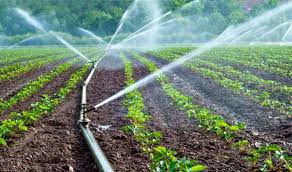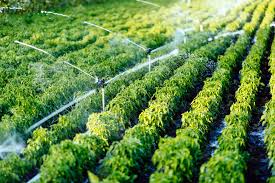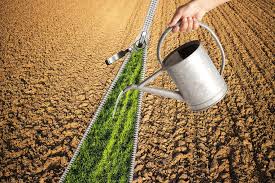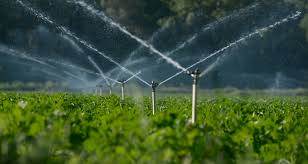Water is an important component in agricultural production and development. The issue of water shortage or insufficient water for agricultural production is addressed through irrigation.
Irrigation is the artificial application of water on land in the absence of rainfall or where natural water is scarce or unavailable. Irrigation facilitates multiple cropping and increases crop productivity.
In this article, an understanding is provided of the need for irrigation, the importance of irrigation, and the sources of irrigation.
Read Also: How to Use Scent Leaf to Cure Infection
Need for Irrigation in Agriculture

Agriculture largely depends on rainfall. Most cropped areas in Nigeria depend exclusively on rainfall, and the rainfall pattern determines the type of crop and animal produced as well as productive efficiency in agriculture.
When rainfall is scanty, it becomes very important to make water available to farmers through irrigation. The uncertain nature of rainfall increases the need for water irrigation in agriculture.
Irrigation is mostly needed in areas where the natural water supply is a significant problem. The need for irrigation arises due to its enormous advantages for the soil, sunshine, and climate.
More water is required in a sandy soil than in a loamy or alluvial soil. In the dry season, there is little or insufficient residual soil moisture available to support the growth and performance of crops and multiple cropping. Hence, it is imperative to irrigate the land.
It is also necessary to have adequate irrigation facilities because certain crops require a very large quantity of water while others require water for a long period.
For example, grain crops cannot grow well if water availability in the soil is low. Sugarcane, in addition, requires water in large quantities and for an extended period. Irrigation is therefore necessary due to the different water requirements of various crops.
The need for irrigation also emerges as a result of its employment potential for poor farmers. It provides micro-employment opportunities for farmers and farm families. Irrigation is capable of increasing both the employment, yield, and income capacity of land, with a consequent increase in the standard of living of farm families.
It can even transform an average unit of cultivation into a viable unit. The need for irrigation also arises in order to solve the acute problems of high inter-temporal and inter-regional variability in rainfall, meet the requirements of higher cropping intensity, and support water-loving crops such as rice and sugarcane, thereby improving yield, income, and employment potential for the farming population.
Importance of Irrigation in Agriculture

The importance of irrigation in agriculture and for farm families cannot be overemphasized. Its significance may be examined from the following points of view:
1. Unequal Rainfall: Most agricultural production activities rely on natural water sources, primarily rainfall. Rainfall patterns in Nigeria vary from one geo-ecological zone to another. In the northern parts of the country, rainfall occurs for a period of four to five months, while the remaining parts of the year experience rainfall uncertainty. In such cases, artificial irrigation facilities are very important to substitute for water shortages.
2. Uncertain Rainfall: It is uncertain whether rainfall will occur within the expected or stipulated period. The distribution is not uniform; rainfall may come earlier before planting, forcing farmers to plant when subsequent rainfall is absent, leading to crop failure. This variation is unfavorable to achieving good yield, as there may be drought at one time and flood at another; crop planning becomes possible only with adequate irrigation facilities.
3. Prosperity: An adequate water supply has great prospects for agricultural production in terms of income generation, employment opportunity, capital formation, general welfare, and the standard of living of farm families.
4. Source of Government Income: Applying irrigation water to farms has a multiplier effect of increased output and high income generation for both the farmer and the government.
5. Increase in Production and Productivity: Double or multiple cropping is possible with the application of irrigation water. With an adverse land-to-man ratio, extensive cultivation may yield very little. High yields can be achieved from irrigated land since it is possible to apply other inputs such as fertilizers, growth-inducing hormones, insecticides, pesticides, and high-yielding varieties of seeds—in conjunction with irrigation water.
6. Increase in Cultivable Land: Uncultivated land resulting from acute water shortages can be put to use with the availability of irrigation facilities. Wasteland can also be used for cultivation if irrigation water is available.
7. Flood Control: Flood problems are often caused by the excessive overflow of river and rainwater. When river water is well channeled and controlled at proper places, it can serve as a source of both electricity and irrigation, especially when provisions are made for electricity extraction.
8. Intensive Cultivation: Multiple cropping can be achieved if sufficient irrigation water is available. Double, triple, or multiple crops can be produced on a given area of cultivable land with irrigation.
For example, it is possible to produce crops such as maize two or three times in a year if irrigation facilities are available. Intensive cultivation such as timely planting, weeding, fertilizer application, and other agronomical operations may not be possible without sufficient irrigation water.
9. Making Land Available for Non-Crop Use: Increased food production through irrigation implies that more land will be made available for non-crop sectors. Also, inferior quality or non-productive land used for crops like food grains can be utilized where better returns could be attained. Land may also be made available for non-agricultural uses such as roads, railways, houses, and recreational centers.
10. Commercial Farming: The development of irrigation facilities and the application of irrigation water can lead to commercial agricultural production.
11. Employment: The development of irrigation facilities can provide job opportunities as agricultural production activities increase through double, triple, or multiple cropping systems. With sufficient irrigation water, land reclamation can be achieved, paving the way for further agricultural development.
Read Also: How to Prevent Cannibalism in Catfish Farming
Sources of Irrigation for Agriculture

The main sources of irrigation are discussed below.
1. Well Irrigation
In most countries of the world, wells form a very good source of water for irrigation. Wells can be successfully dug to supply water in areas where there is adequate sub-soil water. Well irrigation has been practiced in Nigeria since ancient times and remains important due to its economic and environmental value.
Advantages:
i. Well irrigation does not require extensive technical know-how.
ii. The operational cost is nominal and easily affordable by farmers.
iii. Water from wells contains certain chemical properties that help increase soil fertility.
Disadvantages:
i. It is not considered suitable for use all over the country.
ii. In areas where the well water table is too high, constructing wells is expensive and troublesome.
iii. In certain parts of the country, wells dry up during the dry season.
iv. It is not suitable as a source of irrigation water for large and commercial farms.
v. Engines and pump sets may be required to generate water from wells on large farms; otherwise, several wells may be needed to achieve the purpose.
2. Tube Wells
Tube wells are considered an important component of the green revolution, providing an assured source of irrigation water.
Advantages:
i. Tube wells are not only cheaper compared to surface wells, but they also help relieve overworked cattle from the strain of drawing water from traditional wells.
ii. Tube wells have the advantage of irrigating large fields in a short time.
iii. They can be easily used by farmers, especially in situations where government grants are provided.
Disadvantages:
- The major limitation of tube wells is that they cannot conveniently be used in the absence of electricity.
- Tube wells cannot be used where there is insufficient water supply.
3. Tanks
Tanks form an important source of irrigation water, commonly used in areas where the availability of underground water is poor because rocks do not absorb water. In such conditions, constructing wells is often very difficult.
Water can easily be stored in tanks, which may be available in natural or artificial forms. The basic limitations of this method of irrigation include challenges in administration, raising water to the field, and maintenance issues.
4. Canal Irrigation
Canal irrigation is the most important source of irrigation water in the present day, accounting for about forty percent of the net irrigated land. There are two major types of canal irrigation: inundation canals and perennial canals.
i. Inundation Canals: These are constructed to allow the free flow of water from a river without any bank or dam at the head. During the rainy season, when the water flow from the river is high, the canals overflow and irrigate the field. However, during the off-season, as the river dries up, the canals also dry, making water availability for irrigation uncertain. This type of irrigation may not be very useful during droughts when water is most needed.
ii. Perennial Canals: In this method, water is stored at the site with dams built at higher levels. Water is supplied throughout the year regardless of the river’s status. These canals are usually regarded as the most suitable since they are permanent in nature and provide a regular water supply, even during drought.
iii. Limitations of Canal Irrigation:
i. Canal irrigation cannot be conveniently constructed everywhere.
ii. Canals go dry when the river source dries up.
iii. There may be water loss resulting from seepage, evaporation, and pilferage.
iv. Water seepage from canals may lead to additional problems such as flooding.
v. Water wastage may occur as a result of the water rate system, irrational demand for water, and insufficient service by the irrigation department.
This article has addressed the need for irrigation, the importance of irrigation, and the sources of irrigation in agriculture. The discussion highlights the critical role of irrigation in addressing water shortages and improving agricultural productivity and development.
Do you have any questions, suggestions, or contributions? If so, please feel free to use the comment box below to share your thoughts. We also encourage you to kindly share this information with others who might benefit from it. Since we can’t reach everyone at once, we truly appreciate your help in spreading the word. Thank you so much for your support and for sharing!
Read Also: How to Make Your Own Organic Pesticides






